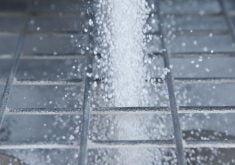Accurate seed treatment Farmers can’t determine the correct rate unless seed volume is known
BRANDON — Determining volume is the biggest challenge when treating seed.
There are three critical elements of seed treatment: seed rate, chemical volume and accurate application of fungicide.
Bob Reekie, a consultant for Bayer Crop Sciences, said the rate must be adjusted constantly because of fluctuations in the density and volume of seed coming through the application machine.
He said a new seed treating device, dubbed STORM for Seed Treatment Optimized Rate Metering, has solved that challenge.
The system is the result of a partnership with Bayer, Westfield and Ag Growth International.
Read Also

Volatile temperatures expected for this winter
DTN is forecasting a lot of temperature variability in the Canadian Prairies this winter. Precipitation should be close to average.
The STORM computer allows the operator to pre-program the recipes for each combination of seed and chemical product. The computer adjusts the chemical rate as the seed volume changes.
Reekie said each recipe is repeatable and easily selected.
“If you’re working with precise volumes of seed and product, it won’t do you any good unless you also have a pump that’s capable of precise liquid metering. We use a special peristaltic pump to ensure the rate is correct,” he said.
“Now that we have accurate metering of both the seed and the chemical, we use a special computer program to marry the two factors together. That gives us total control. As the grain volume changes, the computer instantly matches the new information with new pump instructions so the rate is always accurate.”
Reekie said measuring seed volume in real time requires a volumetric instrument that takes a fixed volume. The volume is compared to the grain density number, which is the bushel weight of the seed, provided by the farmer.
The computer then converts seed data back to a pound measurement, which the computer uses to make the rate calculations.
“That rate will be the application rate on the label. Plus, the computer knows the volume of seed.”
Equipped with those factors, the computer instructs the peristaltic pump to apply a certain rate as the seed passes by. This instruction can change instantly when there is variation in the density of seed on the conveyor.
“Now you can set the conveyor to any speed and any seed volume you want, and the computer will automatically adjust the liquid to match the seed volume,” he said.
The STORM is a prototype, but another dozen units are being built for in-field testing this spring by large volume seed dealers. Ten will go to Bayer customers and two will go to AGI customers.
“When the commercial models go into production, they’ll be able to process from 10 bushels to 40 bu. per minute. That’s 2,400 bushels per hour,” he said. “The big limitation will be how quickly you can remove the wet, treated seed.”
Reekie said production models should be ready for sale this fall. No price has been determined yet.















